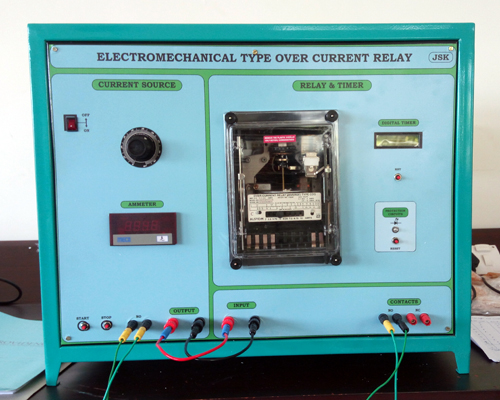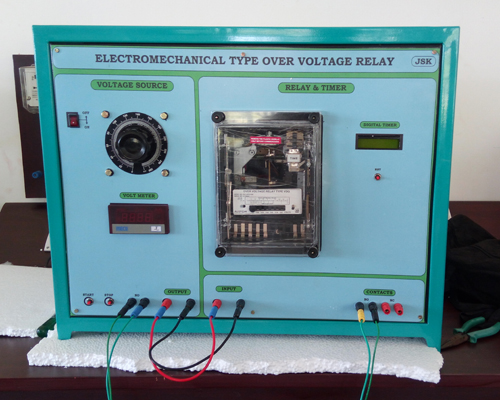In a power system consisting of generators, transformers, transmission, and distribution circuits, it is inevitable that some failure will occur somewhere in the system. When a failure occurs on any part of the system, it must be quickly detected and disconnected from the main supply. There are two principal reasons for it. Firstly, if the fault is not cleared quickly, it may cause unnecessary interruption of service to the customers. Secondly, rapid disconnection of faulted apparatus limits the amount of damage to it and prevents the effects of fault from spreading into the system.
The detection of a fault and disconnection of a faulty section or apparatus can be achieved by using fuses or relays in conjunction with circuit breakers. A fuse performs both detection and interruption functions automatically but its use is limited for the protection of low-voltage circuits only. For high-voltage circuits, relays and circuit breakers are employed to serve the desired function of automatic protective gear. The relays detect the fault and supply information to the circuit breaker, which performs the function of circuit interruption.
SWITCHGEAR AND PROTECTION SYSTEM
Switchgear
Refers to various equipment associated with switching of electrical plants and circuits during normal and abnormal conditions.
Protective Relay
Refers to various subsystems associated with sensing the abnormal operating condition in an electrical plant and consequent alarm, indication and tripping commands to circuit breaker.
Applications of protection system
- Over current protection – Feeders, Lines, Motors, Generators, Transformer, Load circuit, Individual loads.
- Over current protection – Feeders, Lines, Large Motors, Generators, Transformer, Load circuit.
- Differential protection – Large Transformer, Motor, Generator.
- Carrier current protection (Phase comparison of carrier signals) – Feeders, Long over head lines
Principle of operation

The Protective Relays are connected in the secondary circuits of current transformers and/or potential transformers. The Relay senses the abnormal condition and closes the trip circuit of the associated circuit breaker.
Abnormal Conditions
- Overloads
- Loss of synchronism
- Under voltage, Over voltage
- Under frequency
- Reversal of direction of power flow
- Poor power factor
- Voltage swings and Current swings
- Temperature rise
In a power system consisting of generators, transformers, transmission, and distribution circuits, it is inevitable that some failure will occur somewhere in the system. When a failure occurs on any part of the system, it must be quickly detected and disconnected from the main supply. There are two principal reasons for this. Firstly, if the fault is not cleared quickly, it may cause unnecessary interruption of service to the customers. Secondly, rapid disconnection of faulted apparatus limits the amount of damage to it and prevents the effects of fault from spreading into the system.
The detection of a fault and disconnection of a faulty section or apparatus can be achieved by using fuses or relays in conjunction with circuit breakers. A fuse performs both detection and interruption functions automatically but its use is limited for the protection of low-voltage circuits only. For high-voltage circuits, relays and circuit breakers are employed to serve the desired function of automatic protective gear. The relays detect the fault and supply information to the circuit breaker, which performs the function of circuit interruption.
SWITCHGEAR AND PROTECTION SYSTEM
Switchgear
Refers to various equipment associated with switching of electrical plants and circuits during normal and abnormal conditions.
Protective Relay
Refers to various subsystems associated with sensing the abnormal operating condition in an electrical plant and consequent alarm, indication, and tripping commands to the circuit breaker.
Applications of protection system
- Over-current protection – Feeders, Lines, Motors, Generators, Transformer, Load circuit, Individual loads.
- Over-current protection – Feeders, Lines, Large Motors, Generators, Transformer, Load circuit.
- Differential protection – Large Transformer, Motor, Generator.
- Carrier current protection (Phase comparison of carrier signals) – Feeders, Long over headlines
Principle of operation

The Protective Relays are connected in the secondary circuits of current transformers and/or potential transformers. The Relay senses the abnormal condition and closes the trip circuit of the associated circuit breaker.
Abnormal Conditions
- Overloads
- Loss of synchronism
- Under voltage, Over voltage
- Under frequency
- Reversal of direction of power flow
- Poor power factor
- Voltage swings and Current swings
- Temperature rise



